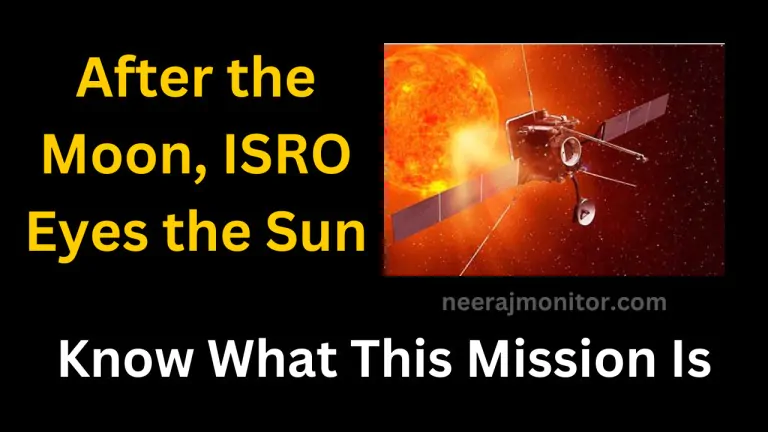ISRO’s ADITYA L1 Mission: Following India’s groundbreaking achievement as the first nation to reach the Moon’s South Pole, the country is now setting its sights even higher. The Indian Space Research Organization (ISRO) has embarked on an ambitious journey towards the Sun. The upcoming ADITYA L1 mission holds paramount importance as it aims to delve into the study of our star, the Sun.
Exploring the ISRO ADITYA-L1 Mission
In the wake of the successful Chandrayaan mission, Prime Minister Narendra Modi addressed both ISRO scientists and the nation. During this address, he unveiled plans for ISRO’s forthcoming endeavors. Among these missions, a notable focus is directed towards the study of the Sun. The question arises: How will ISRO ensure the success of its Aditya L 1 mission, given the formidable challenges posed by the intense solar environment?
Understanding the ADITYA L1 (Suryaaan) Mission
Following their triumph in landing a spacecraft on the Moon’s South Pole, Indian Space Research Organization scientists are now setting their sights on an even greater endeavor—exploring the Sun. This aspiration has manifested as the Aditya L1 mission, also referred to as Suryaan. The mission’s core objective involves the study of Coronal Mass Ejections emanating from the Sun. In essence, ISRO scientists will delve into the research of solar flares.
Goals of the ADITYA L1 Mission
The purpose of the ADITYA L1 mission, conducted by ISRO, becomes clear upon visiting the official website of the organization. The Sun undergoes diverse reactions at various times, resulting in abrupt surges of energy. These energy surges, known as coronal mass ejections, exert an impact not only on Earth’s atmosphere but also on satellites in space. The question naturally arises: How can a satellite be placed in proximity to the intensely hot Sun? The answer is embedded in the name of the satellite itself.
Decoding the L1 Point
The ISRO mission dedicated to solar research has been christened Aditya L1. “Aditya” signifies the Sun, while “L1” refers to a specific orbit. L1 denotes a point between the Earth and the Sun where gravitational forces from both celestial bodies neutralize, resulting in zero net gravity. In other words, the Sun’s gravitational pull and Earth’s gravitational force counterbalance each other. This unique point is also known as a Lagrangian point. Among the five such points, L1 emerges as an optimal location for solar study due to the complete nullification of gravitational influences. The distance of this point from Earth is approximately 1.5 million kilometers.
Satellite Positioning at L1
The Aditya L1 mission strategically positions its satellite at the L1 orbit, a boundary beyond which no satellite can venture. This positioning safeguards the satellite from the Sun’s intense heat. Aditya L1, an Indian mission, will comprehensively study the Sun from this secure vantage point.
Focus Areas of ADITYA L1 Research
ISRO’s official website outlines that the Aditya L1 payload will address critical aspects of space weather dynamics, particle diffusion in regions, coronal heating, coronal mass ejections, pre-flare phenomena, and their attributes. This research will contribute vital insights to enhance our understanding.
Payload Configuration on ADITYA L1
The Aditya L1 mission incorporates a total of seven distinct payloads. These payloads are geared towards analyzing solar radiation. ISRO will deploy advanced high-megapixel cameras within the satellite. Among the payloads, four will facilitate remote sensing of the Sun, while the remaining three will facilitate in-situ observations.
Sole Focus on Solar Study
The Indian Space Research Organization’s endeavor is groundbreaking—it marks the nation’s first exclusive mission dedicated solely to solar research. The spacecraft will be stationed at Lagrange point 1, a unique location in the solar system between the Sun and Earth. The inherent advantage of this point lies in its minimal energy requirements for observatory operations.
Scheduled Launch Date of the Aditya L1 Mission
ISRO is set to launch the Aditya L1 mission on September 2 of the current year. The launch will take place at the Satish Dhawan Space Center in Sriharikota.
Journey Time to Reach the Sun
Drawing from the Chandrayaan 3 mission’s trajectory, which took approximately 40 days to successfully land after launch, the Aditya L1 mission is anticipated to take around 110 days to reach the L1 point in the Sun’s orbit. This prolonged journey is attributed to the substantial distance of around 1.5 million kilometers separating Earth from the L1 point. It’s important to note that the Aditya L1 mission will be propelled into space using the PSLV rocket.
Read Also:
Chandrayaan 3: India’s Third Lunar Mission to Explore the South Pole
Information about ISRO | Information about ISRO for project | Information about ISRO for students
Q: What is the purpose of the Aditya L1 mission?
A: The Aditya L1 mission aims to investigate the Sun.
Q: Which organization is responsible for launching the Aditya L1 mission?
A: The Indian Space Research Organization, also known as ISRO, will be launching the Aditya L1 mission.
Q: Is there another name for the Aditya L1 mission?
A: Yes, it is also referred to as “Suryaan.”
Q: When is the scheduled launch date for the Aditya L1 mission?
A: The Aditya L1 mission is set to be launched on September 2nd.
Q: How long is the estimated journey time for Aditya L1 to reach the Sun?
A: Aditya L1 is expected to take approximately 110 days to reach the Sun.
Q: From which rocket will the Aditya L1 mission be launched?
A: The Aditya L1 mission will be launched using the PSLV rocket.
